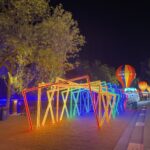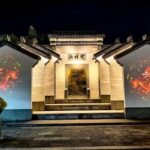The 37th China·Qinhuai Lantern Festival. The Qinhuai Lantern Festival, also known as ‘Jinling Lantern Festival’, ‘Confucius Temple Lantern Festival’, and ‘Nanjing Lantern Festival’, is mainly held during the Spring Festival and Lantern Festival every year. Impressive Qinhuai, with resplendent lanterns; ten miles of prosperity, ancient charm and leisure. Among the numerous intangible cultural heritage items in Qinhuai like shining stars, the ‘Qinhuai Lantern Festival’ is undoubtedly one of the most dazzling.
Since the Qinhuai District resumed holding the annual ‘Qinhuai Lantern Festival’ in 1986, the Qinhuai Lantern Festival has made great progress. In 2006, the ‘Qinhuai Lantern Festival’ was selected into the first batch of national intangible cultural heritage list, making a name for the ‘brand’ of Qinhuai culture. Nowadays, the folk traditional custom of ‘going to Confucius Temple to enjoy lanterns during the Spring Festival’ has long been one of the essential activities for Nanjing citizens to celebrate the New Year. This year’s lantern festival is mainly held in Confucius Temple, Men Dong, and the ten-mile Qinhuai water tour route, while also taking into account the creation of festival atmosphere around Confucius Temple, with various lantern groups set up. 1. Exhibition area in the core scenic area of Confucius Temple. There are 31 lantern groups set up in ticketed scenic spots such as Dacheng Hall and the Imperial Examination Museum (including the South Courtyard) and public areas of the central square of Confucius Temple. With excellent traditional Chinese culture as the creativity, it shows the essence and unique charm of Chinese culture.2. Exhibition area on the ten-mile Qinhuai water. There are 8 lantern groups set up along the east five-mile water tour route and the tour route from Dongshuiguan to Fucheng Bridge, connecting cultural and historical scenic spots such as Wuyi Alley, Zhuque Street, Taoyedu, and Dongshuiguan, creating a bright atmosphere for the water tour route.

3. Exhibition area in Laomendong. There are 40 lantern groups set up at important nodes on the main street of Laomendong block and on both sides of branch alleys, as well as important nodes in Xiaoxihu block. With the theme of ‘Jade Rabbit Welcoming Spring’, it uses modern and fashionable expression techniques and combines modern light sources to create a strong festival atmosphere.

4. Public atmosphere exhibition area. There are 14 lantern groups set up at the East Archway of Confucius Temple, the North Archway of Confucius Temple, the West Archway of Confucius Temple, the archway on Zhanyuan Road, the archway on Pingjiangfu Road, the North Square of Confucius Temple, Pingjiangfu Bridge, Laiyan Bridge, Dashiba Street (east and west entrances), Gongyuan West Street, Jinling Road, Qinhuai Gifts (entrance), Xiyuanli (entrances on Gongyuan Street and Pingjiangfu Road), and the rotary on Zhanyuan Road.

At night, colorful lights are lit up everywhere in the scenic area, extremely magnificent. ‘Mooring on the Qinhuai River at night’ is even more wonderful. The scenic belt has festival activities in all seasons, such as the spring cultural temple fair, summer Qinhuai Summer, autumn Confucius Temple Food Festival, and winter Jinling Lantern Festival. In addition to the Confucius Temple, there are also Zhan Garden, Jiangnan Examination Hall, the ancient imperial examination site in China, the former residence of Li Xiangjun, a legendary figure in ‘The Peach Blossom Fan’ in the late Ming and early Qing dynasties, Wuyi Lane, the former residence of Wang Dao and Xie An in the Eastern Jin Dynasty, Bailuzhou Park, the private garden of Xu Da, a founding hero in the Ming Dynasty, Zhonghuamen, a barbican city, and the former residence of Wu Jingzi, the author of ‘The Scholars’.
Food and play. Along the Qinhuai River, food is also a major feature. There are teahouses, restaurants and street snacks everywhere. Among them, ‘Eight Delicacies of Qinhuai’ are worth a taste. ‘Eight Delicacies of Qinhuai’ refers to sixteen famous dishes from eight snack bars in Nanjing, namely: spiced tea eggs and spiced beans from Kuiguang Pavilion; crab shell yellow烧饼 and dried shredded meat with dried shrimps from Yonghe Garden; duck oil crispy烧饼 and sesame oil dried shredded meat from Qifang Pavilion; scallion oil cake and tofu curd from Liufengju; assorted vegetable buns and shredded chicken noodles from Qifang Pavilion; beef pot stickers and beef soup from Jiangyouji; thin-skinned dumplings and red soup fish noodles from Zhan Garden Noodle Restaurant; five-color small cakes and osmanthus-filled small glutinous rice dumplings from Lianhu Cake Shop. Shopping. This area is also a lively commercial area with various shops standing. There are both characteristic traditional souvenirs and fashionable gadgets. You can choose some favorite items as souvenirs. Qinhuai pleasure boats. If you want to take a boat on the Qinhuai River, you can board the boat at the dock opposite the Confucius Temple. There are explanations of scenic spots on the cruise ships. On the boat, you can enjoy the scenery while learning about historical stories. Open all year round, open all day.








